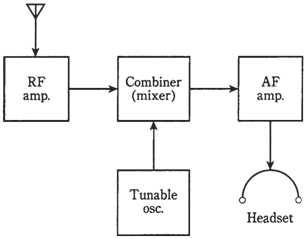Detection of CW signals
If you tune in the unmodulated carrier with the envelope detector, you will not hear anything. A keyed carrier may produce barely audible thumps or clicks, but it will be impossible to read code.For the detection of CW, it is necessary to inject a signal into receiver a few hundred hertz from carrier. This injected signal will beat against carrier, producing a tone whose frequency is difference between carrier and injected-signal frequencies. The injected signal can be produced by a beat-frequency oscillator (BFO). The beating takes place in a signal combiner or mixer.
A block diagram of the simple CW receiver is shown in the given figure. The BFO is tunable. Assume that there is a CW signal at 3.550 MHz. As BFO reaches 3.550 MHz from below, a high-pitched tone will appear at output. When the BFO reaches 3.549 MHz, tone will be 3.550–3.549 MHz, or 1 kHz. This is a comfortable listening pitch for most of the people. The BFO setting is not too critical; actually it can be changed to obtain different tone pitch if you get tired of listening to 1 pitch. As BFO frequency passes 3.550 MHz, pitch will descend to a rumble, then to a swish-swish sound. As BFO frequency continues to rise, the tone pitch will increase again, ultimately rising beyond the range of human hearing.

Figure--Block diagram of a simple direct-conversion receiver for CW, FSK, and SSB.
The demodulation scheme is called as heterodyne detection. A receiver which makes use of the heterodyne detector is called as direct-conversion receiver.